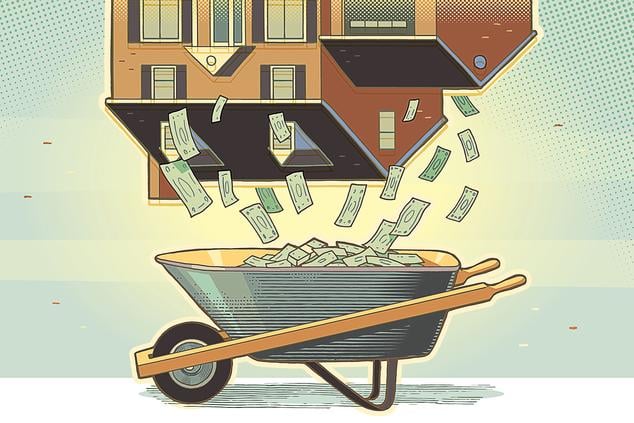If you’re retiring and trying to meet your expenses on a fixed income, a reverse mortgage may seem appealing. However, following closer examination, reverse mortgages may appear less enticing.
There are numerous reverse mortgage frauds, but lenders can also charge exorbitant fees and closing charges, and borrowers must pay for mortgage insurance. Reverse mortgages may also have variable interest rates, which means your overall expenses may change in the future.
If you believe a reverse mortgage could help you stay in your house during retirement, be sure you understand how it will work, the pros and cons so you can make an informed decision.
What Is a Reverse Mortgage?
A reverse mortgage is a loan where a homeowner 62 or older with significant home equity can borrow against the value of their property and receive funds in the form of a lump sum, set monthly payment, or line of credit. In contrast to forward mortgages, which is used to purchase a home, reverse mortgages does not require the homeowner to make any loan payments.
How Does a Reverse Mortgage Work?
A reverse mortgage works by first using the equity you’ve accumulated in your house to pay down your current mortgage. The remainder of the revenues might then be received from the lender as a lump sum, line of credit, or monthly installments. It is not a regular mortgage; rather, it pays off your traditional mortgage, and you are not required to make any payments on the loan until it is due. You must, however, continue to pay your property taxes, homeowners’ insurance, and home maintenance charges, just as you would with a standard mortgage.
Other requirements for reverse mortgages exist in addition to the financial commitments outlined above. To qualify for a reverse mortgage, you must be at least 62 years old and have sufficient equity in your home. You can own the home outright or with a mortgage, and it must be your principal residence.
The home equity conversion mortgage (HECM), which is guaranteed by the Federal Housing Administration, is the most popular type of reverse mortgage (FHA). This can help to safeguard the borrower. If you want a HECM, you’ll have to go through a financial evaluation to confirm you’re willing and able to meet the loan’s financial responsibilities. You must also attend a counseling session to ensure that you understand the terms of the loan and that you will eventually repay it.
Different Types of Reverse Mortgages
There are various types of reverse mortgages, each of which addresses a particular financial need.
#1. Home Equity Conversion Mortgage (HECM)
This is the most common type of reverse mortgage. These federally insured mortgages have greater initial expenses but can be utilized for any purpose. You can also pick how the money is withdrawn, such as through regular monthly installments or a line of credit (or both options simultaneously). Although widely available, HECMs are only available from FHA-approved lenders, and all borrowers must obtain HUD-approved counseling before to closing.
#2. Private Reverse Mortgages
A private loan that is not backed by the government. This type of reverse mortgage often provides a greater loan advance, especially if you own a higher-valued home.
#3. Single-purpose reverse mortgage
This mortgage is less frequent than the others and is typically issued by nonprofit organizations as well as state and local government entities. A single-purpose mortgage is the least expensive of the three options; however, borrowers can only use the loan (which is typically for a much smaller amount) for one specific purpose, such as a handicap accessible remodel, explains Jackie Boies, senior director of housing and bankruptcy services for Money Management International, a nonprofit debt counselor based in Sugar Land, Texas.
When Must You Pay Back the Reverse Mortgage?
Although you are not obligated to make monthly payments on your reverse mortgage, the loan will ultimately become due and must be repaid. A reverse mortgage must be repaid in the following ways:
- When the borrower is no longer alive.
- When the borrower no longer lives in the house or it is no longer their primary residence.
- When the borrower sells or transfers ownership of the residence.
- If the borrower fails to meet their loan requirements, such as paying property taxes and homeowners insurance.
How Do You Pay Back A Reverse Mortgage?
Reverse mortgages are often repaid with the proceeds from the sale of the home. If you die before the loan is due, your heirs will be responsible for arranging the repayment and will have a few alternatives for repaying the amount:
- Sell your home and utilize the cash to pay off your loan.
- Refinance into a regular mortgage or utilize their funds to acquire the home for the loan balance or 95 percent of the appraised value, whichever is smaller.
- Turn over the title to the lender and walk away from the loan.
Pros of Reverse Mortgage
If you’re having trouble meeting your financial obligations, a reverse mortgage may be able to help. Here are a few advantages to getting reverse mortgages.
#1. Aids in the Security of Your Retirement
Reverse mortgages are perfect for retirees who don’t have much money saved or invested but have a lot of value built up in their homes. Reverse mortgages convert an otherwise illiquid asset into cash that can be used to meet retirement needs.
#2. You Can Remain at Home.
Instead of selling your home to liquidate your asset, you can maintain the property and still earn cash out of it. This implies that if you had to relocate, you wouldn’t have to worry about downsizing or being priced out of your community.
#3. You will pay off your existing mortgage.
Reverse mortgages do not require that your home be paid off. In fact, the earnings of a reverse mortgage can be used to pay down an existing home loan. This frees up funds for other expenditures.
#4. You will not be subject to taxation.
The IRS considers money received from a reverse mortgage to be a loan advance rather than income. That is, unlike other types of retirement income such as 401(k) or IRA distributions, the monies are not taxed.
#5. You are protected if the balance exceeds the value of your home.
In some situations, the total amount payable on the reverse mortgage may be less than the value of your home. This can occur if, for example, property prices plummet. If this occurs, your successors will not be responsible for paying the debt.
Cons of Reverse Mortgage
So, what are the drawbacks of a reverse mortgage? Though there appear to be numerous advantages, there are also some important hazards to consider.
#1. You May Lose Your Home Due to Foreclosure
To qualify for a reverse mortgage, you must be able to pay your property taxes, homeowners’ insurance, HOA fees, and other expenses associated with home ownership. You must also dwell inside the house as your primary residence for most of the year.
If you fall behind on these expenses at any point throughout the loan duration or spend the bulk of the year living outside the property, you may default on the reverse mortgage and lose your house to foreclosure.
#2. Your Heirs May Receive Less
Homeownership is an important step in accumulating generational wealth. A reverse mortgage, on the other hand, usually necessitates the sale of the home in order to settle the debt. When you die, your heirs must pay the whole loan sum or 95% of the home’s appraised value, whichever is smaller. Typically, this entails selling the home or handing over the property to the lender in order to satisfy the debt.
Not to mention that a reverse mortgage depletes the equity in your home. By the time it is due to be paid off, there may be no equity left to your heirs.
#3. It Isn’t Free
A reverse mortgage does not require payments, but it does have a number of costs associated with it. You must not only pay your taxes, insurance, and HOA fees, but you must also pay an upfront insurance premium. This is usually 2% of the appraised value of your home. You will also be charged origination fees at the time of closing. You can choose to roll these fees into your loan balance, but you will receive less money.
#4. It may have an impact on your other retirement benefits.
Although a reverse mortgage is not considered income for tax purposes, it may affect your eligibility for other need-based government programs such as Medicaid or Supplemental Security Income (SSI). It’s a good idea to consult with a benefits consultant to ensure your eligibility isn’t jeopardized.
#5. Reverse Mortgages Are Difficult
Reverse mortgages have several laws and restrictions. These loans carry numerous hazards that may not be worth the extra money. You should be careful of any reverse mortgage offer until you thoroughly grasp the details.
Is It Possible To Get Out Of A Reverse Mortgage?
There are a few options if you wish to get out of a reverse mortgage. Consider your goals and financial position while selecting which choice is best for you. Some solutions may incur expenses, while others may necessitate a change in lifestyle, such as moving out of the house. When weighing your alternatives, it’s a good idea to consult with a financial advisor or reverse mortgage counselor who has been approved by the Department of Housing and Urban Development (HUD).
Tips for Getting Out of a Reverse Mortgage
Before entering into a reverse mortgage, make sure you understand how the loan works, the pros and cons of having a reverse mortgage, and your financial obligations, which include paying for closing costs, insurance, and property taxes, and repaying the loan. You’ll also want to make sure you’re aware of your options. All of these topics are covered in reverse mortgage counseling, which is why it is required for the HECM.
If, after all of this thought, you obtain a reverse mortgage and discover that you no longer desire the loan, here are five popular ways to get out.
#1. Exercise Your Rescission Rights
You have three days after closing on your loan to cancel your reverse mortgage transaction without penalty. This is referred to as the right of rescission, and it permits you to change your mind if you experience buyer’s remorse after signing the closing documents. The lender will refund any fees, closing charges, and unused cash paid by the borrower within 20 days.
If you intend to use your right to rescind, you must notify your lender in writing. Remember that this window of time only lasts up to three days after you close. After then, you will be unable to terminate your loan without penalty.
#2. Sell Your Home
Selling the house and using the cash to pay off the debt is one of the simplest methods to get out of reverse mortgages. You’ll keep any remaining selling proceeds after you pay off the debt, depending on how much you owe. So, if you owe $150,000 on the loan and sell the house for $200,000, you will first pay down the debt and then pocket the remaining $50,000.
What happens if you owe more on your home than it is worth? HECMs are non-recourse loans, which means you will never owe more than the value of your property. If you sell your property for less than the loan balance, FHA insurance will cover the difference.
#3. Repay It With Your Own Money
When it comes to repaying the loan, you must pay back the principal amount plus any interest that has accrued. If you want to keep your house and don’t want to sell it, you’ll have to pay back the loan yourself. This could imply using your money to pay it off in one single sum or devising a payment plan in which you make multiple payments to complete it. This may necessitate beginning monthly loan payments and creating a new budget to accommodate those payments.
#4. Refinance Your Reverse Mortgage
Perhaps the issue isn’t the reverse mortgage itself, but rather the precise terms of your reverse mortgage. If this is the case, you may want to think about refinancing your current reverse mortgage into one with better conditions. If interest rates are lower than when you took out your loan, or if the value of your house has grown, you may be able to refinance into a new reverse mortgage. This could result in a lower interest rate, the conversion of an adjustable-rate to a fixed rate, the acceleration of loan repayment, or access to more equity.
Remember that you’ll have to pay closing expenses if you refinance.
#5. Obtain a New Loan
Another option for refinancing is to convert the reverse mortgage into a normal loan. The loan will repay your RM, and you will resume making monthly mortgage payments. This can help you retain and develop the value of your house while also preventing reverse mortgage complications for your heirs if you pass away. Remember that there are closing charges associated with this form of refinancing. Also, you will be required to make monthly payments on your loan. Make sure you can afford this choice before deciding.
Read Also: BEST REVERSE MORTGAGE COMPANIES OF 2023
Who Gains from a Reverse Mortgage?
Homeowners over the age of 62 can use a reverse mortgage to access the equity in their house. The Federal Housing Administration (FHA) insures the great majority of reverse mortgages, therefore if the borrower is unable to repay the obligation, FHA reserves will be used to do so.
Who Reimburses a Reverse Mortgage?
Reverse mortgages are frequently repaid with the cash received from the sale of the primary residence. If the loan falls due after your death, your heirs can sell the house and pay it off.
What Occurs to a Reverse Mortgage after the Owner Passes Away?
A reverse mortgage borrower’s “heirs” may be entitled to benefits after death. A person who is an heir has the legal right to another person’s property after that person’s death. An heir could be a surviving spouse who wasn’t wed to the RM borrower when the loan was taken out.
What Occurs to a Reverse Mortgage after the Owner Passes Away?
Your RM loan becomes due and payable once you, any co-borrower(s), or an eligible non-borrowing spouse, as applicable, have passed away. After receiving the lender’s notice that the debt is due and payable, your heirs have 30 days to buy, sell, or transfer the house over to the lender in order to pay off the obligation.
Can You Utilize a Reverse Mortgage to Sell a House?
You will be required to repay the money you borrowed plus interest and fees if you choose to sell your house while you have a RM loan. You keep the difference if your loan balance is less than what your house sells for.
Conclusion
A reverse mortgage allows older homeowners to supplement their retirement income or pay for house improvements or other needs such as healthcare costs. There are eligibility restrictions that describe who is eligible for this type of loan, how much money can be received, and what the homeowner must do to stay in good standing.
It’s important to consult with a HUD-approved counselor before committing to a reverse mortgage. A counselor can help you weigh the pros and cons of this type of debt, as well as how it will affect your heirs after you die. You can use HUD’s online finder or call the Housing Counseling Line at 800-569-4287 to find an FHA-approved lender or a HUD-approved counseling service.
Reverse Mortgage FAQs
What is the difference between a mortgage and a reverse mortgage?
When you take out a reverse mortgage loan, the title to your property remains in your name, just like with a standard mortgage. However, unlike a typical mortgage, borrowers do not make monthly mortgage payments with a reverse mortgage loan. When the borrower repays the loan.
Who benefits most from a reverse mortgage?
A reverse mortgage is best for someone who owes little or nothing on their initial mortgage and intends to stay in their house for at least five years.
What happens at the end of a reverse mortgage?
If you owe more than your home is worth but sell it for the appraised fair market value, mortgage insurance will cover the difference. The loan must be repaid when the last remaining borrower dies. The majority of heirs will repay the loan by selling the house.






